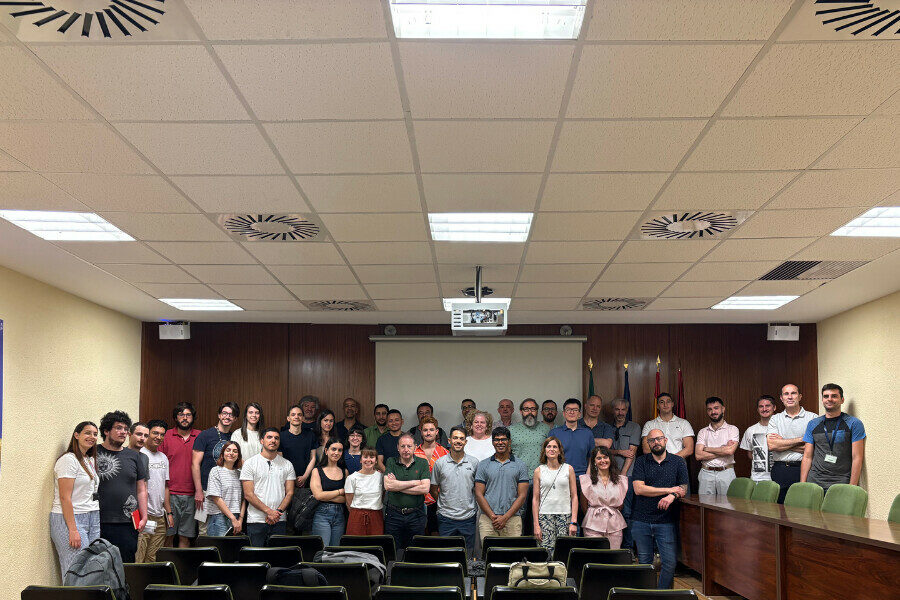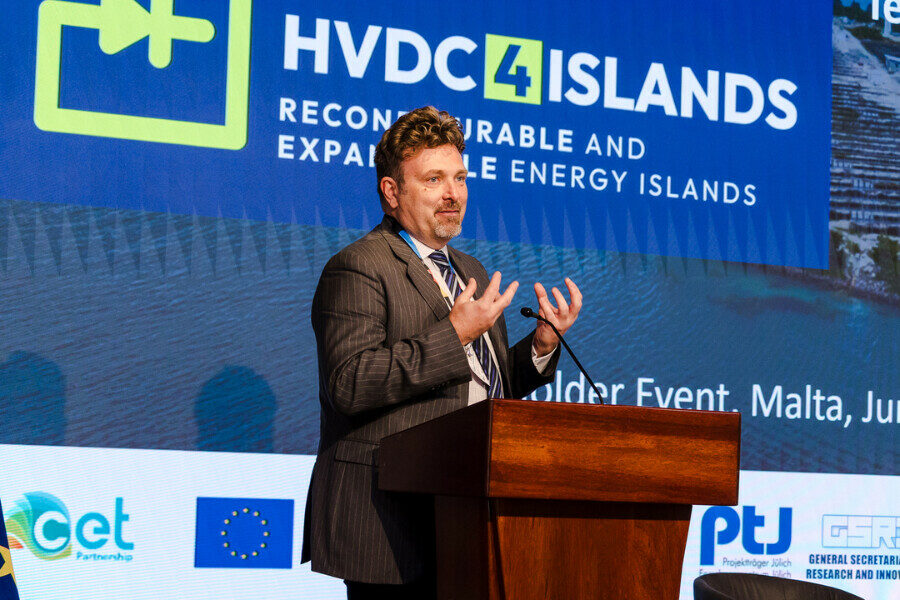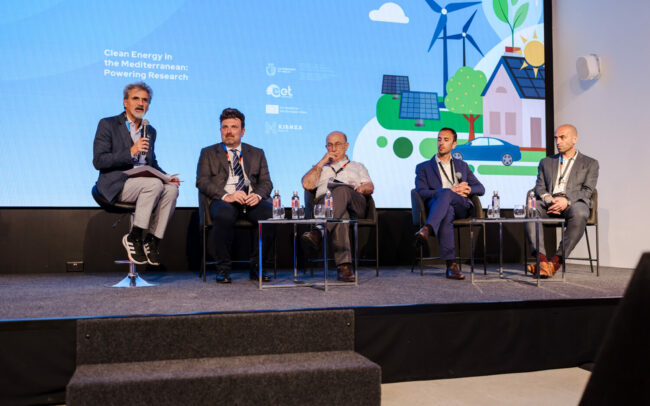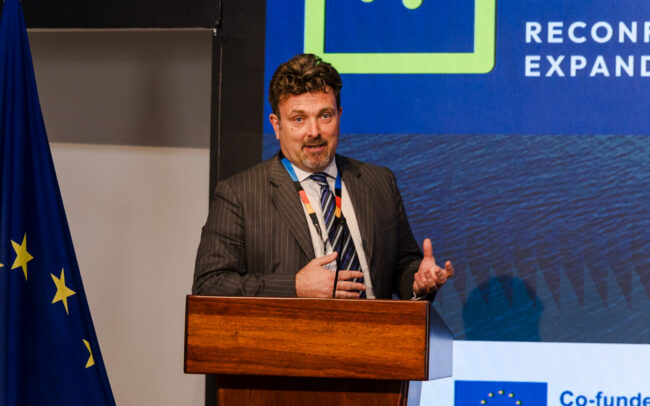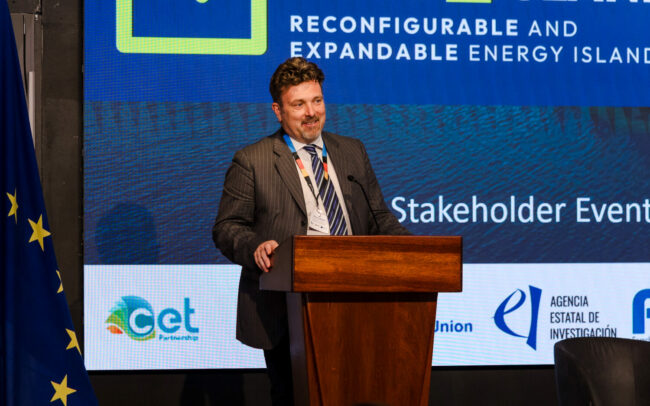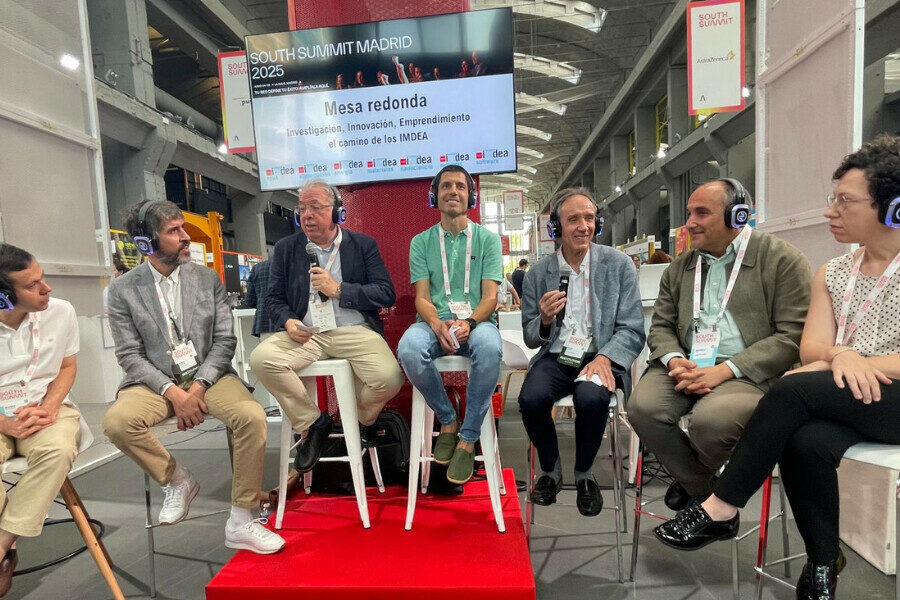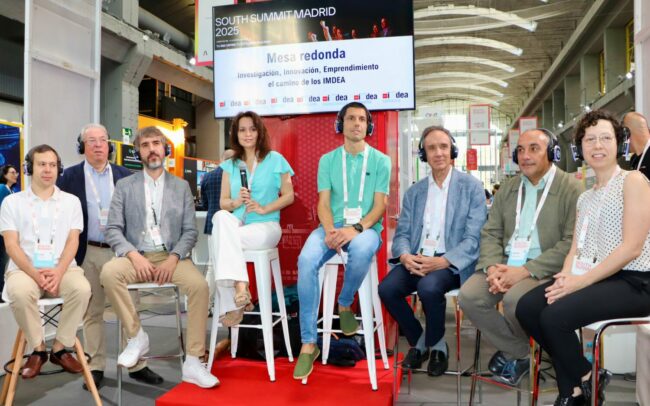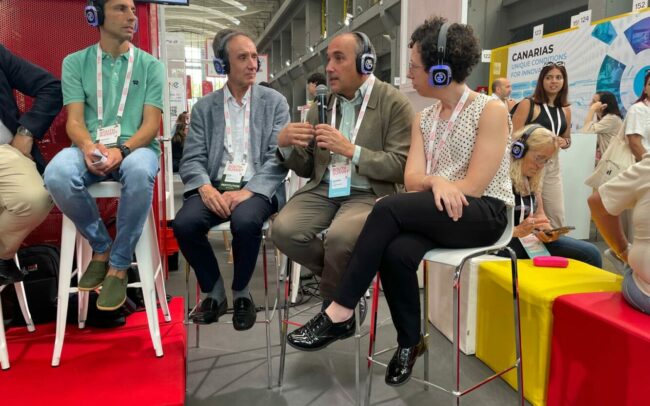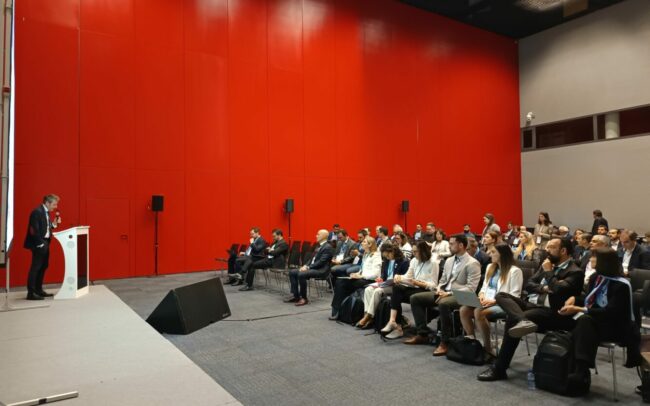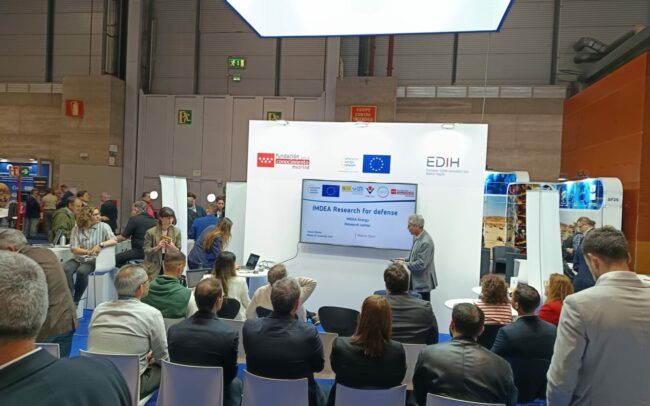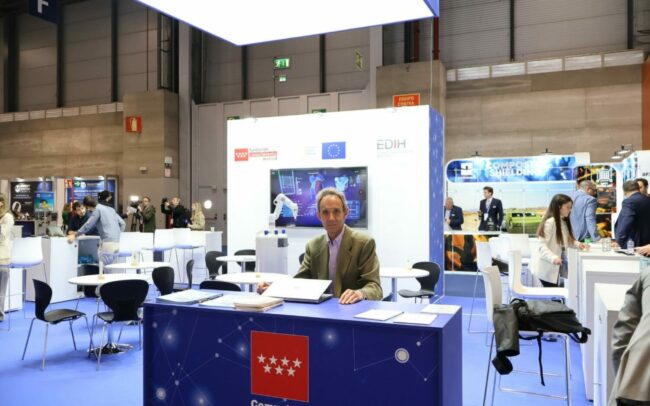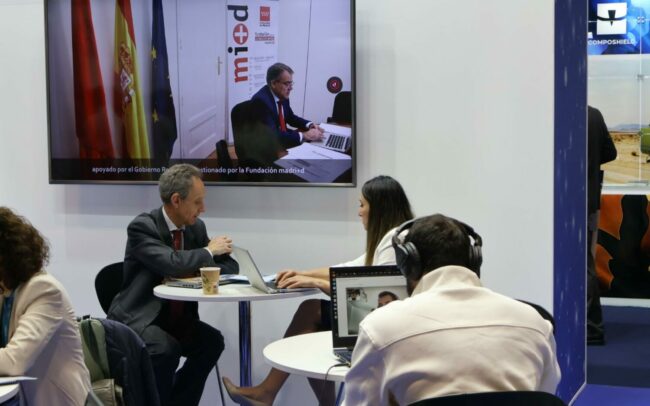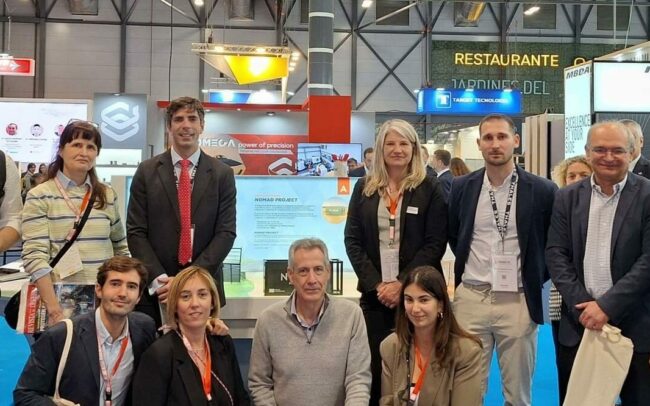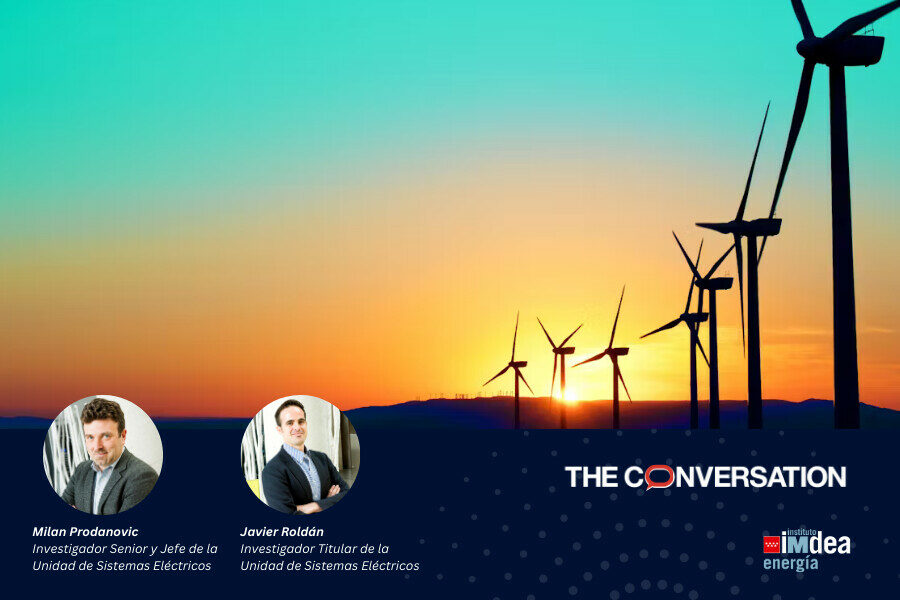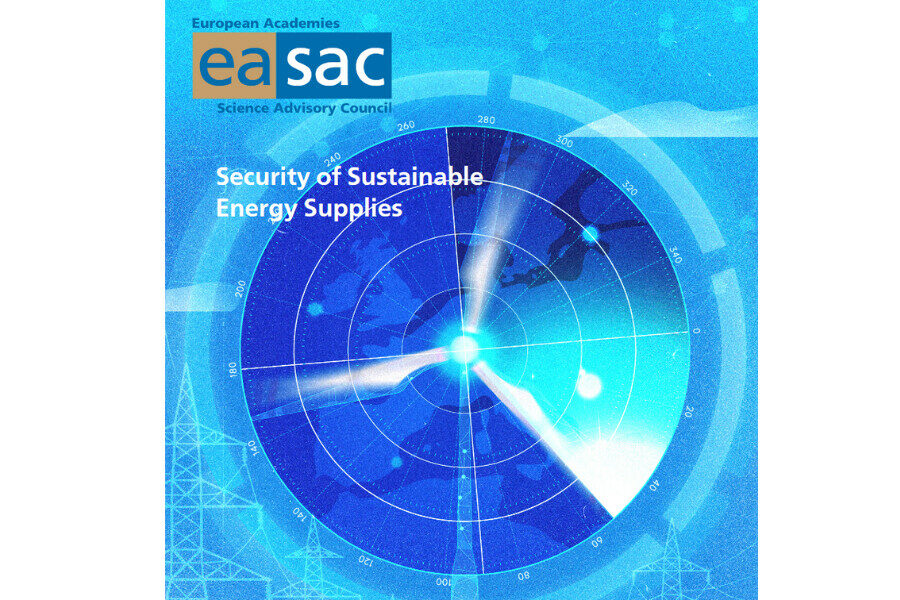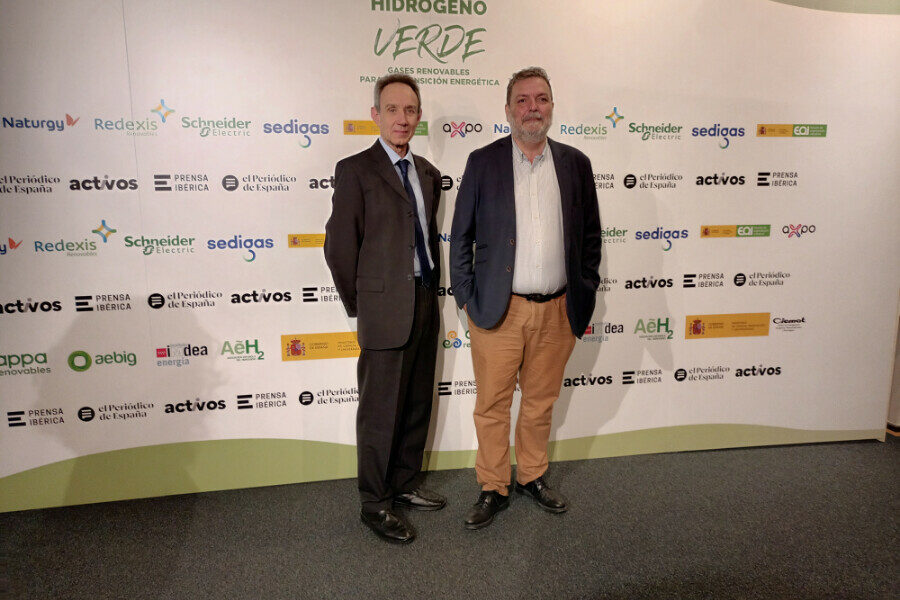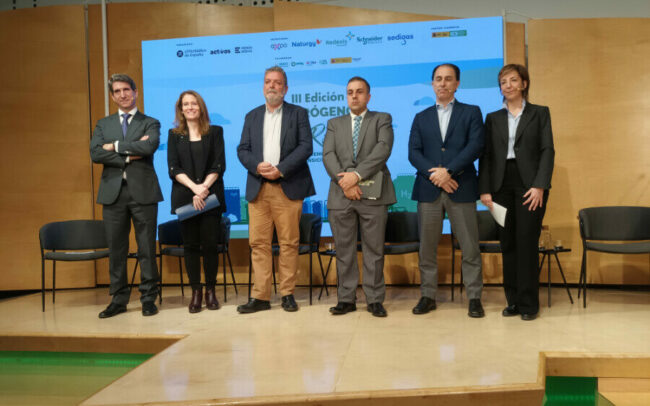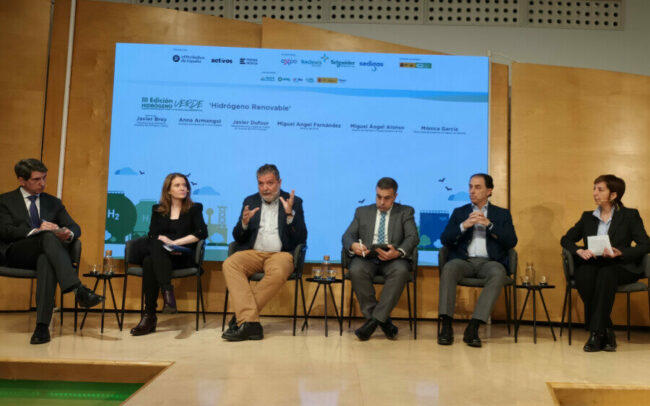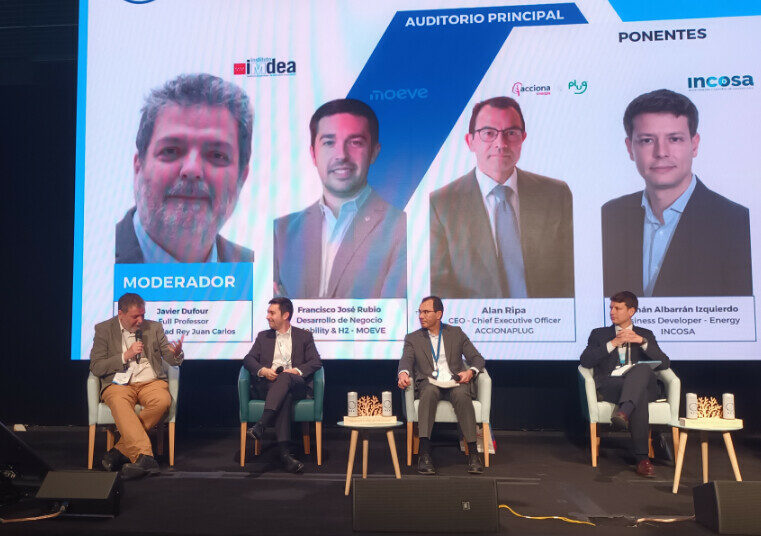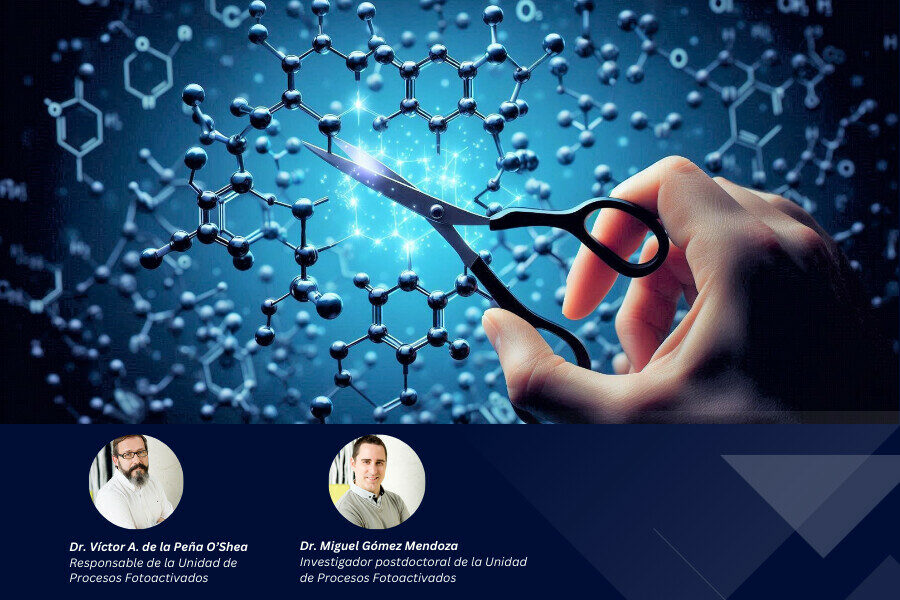FotoArt5.0-CM Project Holds Its First Workshop
On 16 June, the first workshop of the FotoArt5.0-CM project, coordinated by IMDEA Energy, was held at the Autonomus University of Madrid. The event brought together the research teams forming part of the consortium and served as a starting point for face-to-face collaboration between the groups.
During the morning session, a total of 17 brief scientific presentations were delivered, covering key topics such as photocatalysis, electrochemical CO₂ reduction, nanomaterials synthesis, solar catalysis, the development of multifunctional materials, and new applications of robotics and optical sensors in laboratories. The presentations highlighted the interdisciplinary nature of the project and the diversity of technological approaches converging on a common sustainability-focused agenda.
The meeting concluded with an internal coordination session involving the management and scientific committees, where the next steps for the project were outlined. This inaugural workshop not only provided a platform to share progress but also strengthened synergies among the different groups and laid the groundwork for continued collaboration.
The R&D program FotoArt5.0-CM aims to create the first generation of autonomous laboratories in the Madrid region, serving as enabling technologies in the fight against climate change through the development of artificial photosynthesis technologies. This innovative laboratory will leverage artificial intelligence and robotics as key enablers to accelerate the development of advanced materials, which will have a significant impact on other energy technologies by promoting sustainable and clean solutions. This pioneering initiative will position itself as a benchmark in enabling technologies for energy research, establishing Madrid as a leader in cutting-edge energy and digital technology research and development.
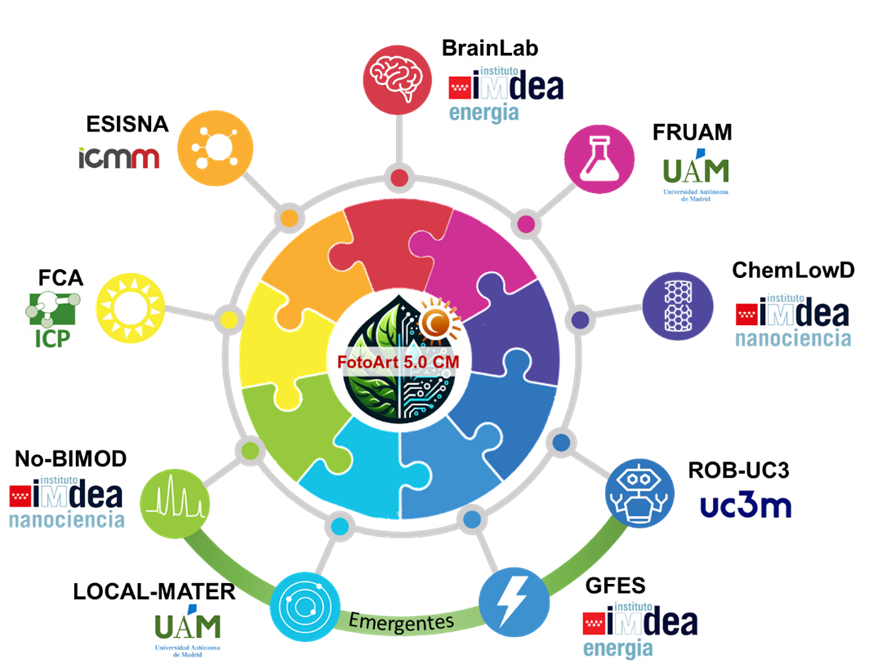
HVDC4ISLANDS drives the energy transition at the event “Clean Energy in the Mediterranean: Powering Research”
On 3 June 2025, IMDEA Energy took part in the international event “Clean Energy in the Mediterranean: Powering Research,” organised by Xjenza Malta at the Planetarium Hall of the Bighi Complex in Kalkara (Malta). This meeting, held as part of the Clean Energy Transition Partnership (CETP) activities, brought together researchers, institutional representatives, energy sector professionals, and other key stakeholders to analyse and discuss the challenges and opportunities in the transition towards clean energy systems in the Mediterranean region.
Milan Prodanovic, Head of the Electrical Systems Analysis Unit, attended as a speaker in the Session: Powering Islands: Integrated Energy Systems for Sustainable Transition. During his presentation, Dr Prodanovic introduced the European project HVDC4ISLANDS, which aims to develop and study advanced technologies based on high-voltage direct current (HVDC) and hybrid DC/AC systems for the creation of reconfigurable energy islands.
In his presentation, Milan highlighted how these technologies can improve the stability and flexibility of island electrical systems, facilitating the integration of renewable sources and enabling efficient and multifaceted management of energy demand. He also explained the progress in developing solutions for interoperability between grids, protection and control adapted to different scenarios, as well as the necessary techno-economic-environmental evaluation for their future deployment.
The HVDC4ISLANDS project seeks to demonstrate the unique potential of energy islands to accelerate the deployment of renewables both on land and at sea, providing flexible options for grid interconnection and new pathways for trading through energy storage, power-to-X technologies, and other innovative services. Expected outcomes include validation of the concept of expandable and reconfigurable energy islands and the development of guidelines to ensure interoperability and system stability in various scenarios.
This event in Malta provided an ideal platform for the exchange of knowledge and experience among international experts, fostering collaborations that help drive technological innovation and build a more sustainable and resilient energy future in the Mediterranean area.
IMDEA Energy at South Summit Madrid 2025
The 14th edition of South Summit 2025, the largest annual event for the entrepreneneurial ecosystem in Southern Europe, was held at La Nave in Madrid from 4 to 6 june under the motto “In motion”. It serves as a global meeting and networking platform for entrepreneurs, investors, tech-based companies (startups), corporations, and research centres developing technologies with potential for market uptake through new enterprises.
This year´s edition brought together over 20,000 attendees, who had the opportunity to connect with more tha 7,500 startups and over 2,100 investors from 134 countries.
Representing IMDEA Energy was Félix Marín, head of Technology Development and Transfer, who took part in the business matchmaking sessions with representatives from tech-based companies such as Cooling Photonics and Trimble, large corporations including Ferrovial, Masorange, Moeve, Repsol, and Sacyr, as well as investors and entrepreneurship support organisations.
Félix also took part in the rountable discussion “Research, Innovation, Entrepreneurship: the IMDEA Path”, opened by Ana Ramírez de Molina, deputy Minister for Universities, Research and Science of the Madrid Regional Goverment, and moderated by Vicente Parras, deputy Director General for Technological Innovation. Participants from various IMDEA Institutes shared the work being carried out at their respective centres, focusing on how research is transformed into innovation and entrepreneurship through concrete examples.
Félix highlighted how IMDEA Energy maintains a long-term strategic collaboration with tech-based companies aimed transferring proprietary technologies, co-developing new technologies, and facilitating their market entry. He emphasised that the so-called “valley of death” also relates to technology development, validation, and scaling-up, and underlined the importance of expanding the scope of research lines.
Finally, he presented the Institute’s forward-looking opportunity radar, structured around four strategic pillars:
-
Decarbonisation, focusing on technologies such as green hydrogen (including electrolysers, fuel cells, and hybrid systems), as well as sustainable mibility solutions (electrification and alternative fuels, among others).
-
Digitalisation, including the integration of AI, digital twins, loT, energy management systems (EMS), and new business models based on blockchain.
-
Decentralisation, by promoting energy self-consumption, battery development and use, and flexible generation and demand management.
-
Circular economy, with initiatives centred on second-life batteries, the recycling of critical materials, and waste valoristaion.
IMDEA Energy participates in FEINDEF 2025
IMDEA Energy took part in the International Defense and Security Exhibition (FEINDEF 2025), held from May 12 to 14 at IFEMA Madrid, one of the most important events in the sector both nationally and internationally. The institute was present at the stand of the Madri+d Knowledge Foundation, which brought together companies, univeristies, and research centers from the Madrid Region offering innovative solutions in the field of defense and security.
Throughout the three-day exhibition, IMDEA Energy showcased its main lines of research and technological capabilities in the area of sustainable energy, with particular emphasis on solutions that may be applied in strategic contexts related to security and defence. The institute’s participation helped to enhance its visibility in this sphere and foster new opportunities for collaboration.
Representing the institute were Félix Marín, Head of Technology Development and Transfer; Jesús Palma, Senior Researcher and Head of the Electrochemical Processes Unit; Enríque García, Senior Researcher in the same unit; Mauro Álvarez, Postdoctoral Researcher in the Thermochemical Processes Unit; and Ariane Herrera, Head of Communications. All of them played and active role in disseminating the institute’s scientific and technological work, attendind meetings and taking part in various briefings and conferences held during the exhibition.
As part of the event’s programme, Jesús Palma took part int the presentation of the Nomad project, funded by the European Defence Fund, and participated in the pitching session organised by Madri+d and the Enterpise Europe Network (EEN), where various national and international entities presented their capabilities with a view to the future collaborations on European projects. Meanwhile Félix Marín attended the national Infoday on Cluster 3 Horizon Europe, “Civil Security fo Society”, co -organised by Madri+d and CDTI, and held bilateral meetings with different stakeholders from the sector during the brokerage event to explore opportunities for collaboration and technology transfer.
How to Guarantee the Stability of Power Grids with a Dominant Share of Renewables
How to Guarantee the Stability of Power Grids with a Dominant Share of Renewables
One of the most important lessons we have learned as engineers over the years is that there are no perfect or infallible systems. Every system, no matter how sophisticated, operates within limits defined by its specifications. When it moves beyond that regime, its behaviour can become unpredictable.
On 28 April, we witnessed an undesirable event: the failure of an entire power system, one of the most complex and costly infrastructures ever built by humankind. This kind of system involves thousands of professionals from various fields – engineering, economics, operations, maintenance, and more – working together every day to ensure that electricity flows continuously, invisibly and silently from generating plants to millions of consumers.
Something clearly fell outside the expected parameters, leading to far-reaching consequences. While there are now many hypotheses, it will take days or even weeks to fully understand what happened. To approach an explanation, it is useful to review how a modern power system functions and maintains its balance.
A Fundamental Balance
From a technical point of view, the power grid is designed to maintain, at all times, a precise balance between the energy generated and the energy consumed. When this balance is disrupted, even for milliseconds, transient instabilities may occur. If the imbalance lasts for more than a few seconds, the risk of system collapse increases significantly.
In alternating current systems, the frequency of the electrical signal – 50 Hz in Europe – acts as a key indicator of this balance. A frequency above the nominal value suggests excess generation; a lower frequency indicates a shortfall. For this reason, Grid Codes establish strict tolerance margins for both frequency and voltage.
If a generator or substation deviates beyond these margins, protection systems are designed to isolate them automatically, avoiding undesirable or unpredictable effects. When it is said that the system “lost generation”, it generally refers to generators being disconnected by these protection mechanisms due to abnormal conditions. This is precisely what happened on 28 April and triggered a chain of events leading to the blackout.
How to Maintain Grid Stability
Historically, grid stability depended on so-called “rotational mass”: the mechanical inertia of large synchronous generators connected directly to the grid. This inertia acted as a natural buffer against fast disturbances, helping to keep the frequency stable in the face of sudden changes in generation or demand.
However, modern renewable sources, such as photovoltaic solar and wind, do not possess this capability. They are connected to the grid via electronic power converters, which, by design, do not automatically respond to frequency variations or actively participate in voltage control, unless specifically programmed to do so.
In addition to its technical dimension, the power system is a sophisticated economic ecosystem. It operates through different markets, mainly the energy market (which defines the hourly generation mix) and the balancing services market (which ensures real-time equilibrium even during contingencies).
These markets aim to minimise the overall cost of energy, but the growing integration of renewables – which, once installed, generate at near-zero marginal cost – increases the need for ancillary services to ensure system stability. In other words, what is gained in economic efficiency may require greater investment in operational reliability.
When Renewables Dominate
April, typically characterised by low electricity demand (due to limited need for heating or air conditioning), is ideal for renewables to cover a large share of consumption. This reduces production costs, but also means operating the grid under low-inertia conditions, with fewer rotating generators and more electronic converters. All indications suggest that the incident on 28 April occurred under these conditions, which undoubtedly contributed to the failure.
Fortunately, modern converters can already be controlled to mimic the behaviour of rotating generation, providing inertia support and helping to stabilise frequency and voltage.
Researchers at the Electrical Systems Unit of IMDEA Energy are developing new control algorithms for power converters that serve as interfaces for renewable sources and batteries. To make this a widespread reality, regulatory changes, economic incentives, and new remuneration schemes that value these services are required.
In countries like Spain, which operate relatively isolated grids, specific markets are already being created for stability services – such as real or virtual inertia – and grid connection requirements are being revised to enable renewables to actively participate in system control.
From an engineer’s perspective, it is clear that, in order to ensure the reliability of power systems under increasingly demanding operating conditions, we must rethink traditional principles of operation. It is not just about adapting, but about defining new specifications for a system – a vital product – that is evolving rapidly and on which we all depend.
David Serrano, Director of IMDEA Energía, Contributes to EASAC Report on Europe’s Energy Supply Security
In April, the European Academies’ Science Advisory Council (EASAC) published a report on the Security of Sustainable Energy Supply in Europe. This document has gained particular relevance following the power outage that occurred on 28 April across the Iberian Peninsula, highlighting the vulnerabilities of current energy systems and the urgent need to strengthen their resilience. The report directly addresses this critical issue: how to ensure a secure, sustainable, and autonomous energy supply for Europe.
David Serrano, Director of IMDEA Energía, played an active role in drafting the report, representing the Royal Academy of Exact, Physical and Natural Sciences of Spain (RAC). His contribution drew on his extensive expertise in sustainable energy technologies and energy transition strategies.
The report warns that Europe’s dependence on imported fossil fuels, particularly oil and gas, is a major source of both economic and political vulnerability. This reliance exposes the continent to external pressures, geopolitical blackmail, and supply disruptions with potentially severe consequences for both industry and households.
According to the report, high and volatile energy prices are undermining investor confidence, weakening industrial competitiveness, and increasing the risk of energy poverty for millions of European citizens.
“The only way to guarantee a secure and affordable energy supply is through a well-managed energy transition based on domestic, sustainable sources and innovative technologies developed in Europe,” the report states.
Key recommendations from the report include:
-
Strengthening cybersecurity in the energy sector.
-
Establishing strategic alliances across the supply chains of key technologies and critical raw materials.
-
Significantly increasing electrification in buildings, industry, and transport.
-
Ensuring access to critical raw materials such as lithium, cobalt, and rare earth elements.
-
Investing in electrical infrastructure and enhancing grid flexibility through energy storage, interconnections, and demand-side response mechanisms.
The report also underscores the strategic importance of initiatives such as the European Green Deal and the recent Net-Zero Industry Act (Clean Industrial Deal) as key instruments to safeguard Europe’s energy sovereignty.
“Every euro invested in sustainable energy is a euro invested in our security,” stated Professor Paula Kivimaa, co-chair of the EASAC working group.
This comprehensive study was developed by 27 scientific experts nominated by their respective national academies. David Serrano’s participation highlights the leading role of IMDEA Energía in the advancement of secure and sustainable energy solutions for Europe’s future.
Read the report: “Security of Sustainable Energy Supplies”
The III Edition of Green Hydrogen – Renewable Gases for the Energy Transition Features IMDEA Energy’s Expertise
The IMDEA Energy Institute participated in the “3rd Edition of Green Hydrogen – Renewable Gases for the Energy Transition”, held at the Bertelesmann Space in Madrid on 25 April 2025.
The event, organized by Prensa Ibérica, focused on renewable gases, produced from renewable sources and waste, and their contribution to reducing the volume and enviromental impact of waste, as well as to the ecological transition by advancing towards carbon neutrality and promoting the devlopment of a circular economy. The agenda addressed both business prospects and future technologies related to biogas and biomethane, renewable gases in recent years.
In summary, the programme emphasised the extraordinary enviromental impact of renewable gases due to the reduction of waste, air pollutants and greenhouse gases, as well as the social and economic benefits they undoubtedly bring to rural areas. The event brought together experts from various organistaions across the hydrogen and sustainable gases value chain, including generation, distribution, marketing and user companies, investors, market agents, research centres, universities and regional administrations.
IMDEA Energy was represented by Javier Dufour, Head of the Systems Analysis Unit, and Félix Marín, Head of Technology Development and Transfer. Javier Dufour participated as an expert in the roundtable discussion on “Renewable Hydrogen”, which covered topics such as the Spanish Recovery and Resilience Plan, the European Hydrogen Bank, the interconnection of national networks, the production, storage, transport and distribution of hydrogen, infrastructure and market issues, as wrll as hydrogen uses in industry (such as chemical synthesis and the steel industry) and mobility.
Other participants in the roundtable included representatives from the European Union, the National Hydrogen Centre, and the companies Alsa and Alkeymia.
IMDEA Energy participates in the new edition of the Why H2 Sustainable Industry Congress
IMDEA Energy participated in the Why H2 Sustainable Industry Congress 2025, held on April 23 and 24 a La Nave, Madrid.
The event brought together experts from a wide range of firms, many of which are part of IMDEA Energy’s collaboration network, including major innovative corporations and technology-based companies from various sectors related to energy, new materials, mobility and engineering. Also present were research centers, universities, regional administarions, port authorities, and key players from the innovation ecosystem, such as the Spanish Patent and Trademark Office (OEPM) and the “Hydrogen Valleys”, among other participants. Together, they shared experiences, innovative technologies, and knowledge, while generating business opportunities and fostering technology transfer.
The IMDEA Energy Institute was represented by Javier Dufour, Head of the Systems Analysis Unit, who moderated the roundtable discussion “Hydrogen and Renewable Energies: Synergies and Opportunities”, featuring representatives from Moeve, Acciona, Plug, Incosa, and EDP Renovables. Félix Marín, Head of Technology Development and Transfer, also represented the institute by participating in the “Speed Networking” business roundtable, where he held meetings with representatives from companies such as Atawey Hydrogen, Bosch, Dovetail Electric Aviation, EDP, Gas Eco, GSI Solar, Incosa, Inhiset, Nordex Electrolyzers, Seaplace, and Suez. These companies showed interest in the technologies developed by IMDEA Energy, the ongoing research projects, and the potential for launching new collaborative R&D initiatives.
Can we control the breaking of chemical bonds to revolutionize molecular engineering?
Oxidation chemistry plays a fundamental role in both synthetic chemistry (the kind carried out in laboratories to create new compounds) and biological chemistry (the kind that occurs in living organisms). These processes have a well-defined reactivity, which means altering them to produce different reactions is difficult and usually requires complex steps. A clear example of this challenge is ozonolysis.
Ozonolysis is a classic reaction in which ozone (O₃) breaks the double bonds of alkenes (a type of molecule with C=C bonds). This reaction is well known and widely taught in organic chemistry courses. However, the ozonolysis of aromatic compounds remains an unsolved challenge. Why? Because aromatic compounds are more stable than alkenes, meaning ozone will preferentially react with alkenes before targeting aromatics. The result is an uncontrolled, non-selective reaction that destroys the molecule instead of modifying it in a useful way.
A new approach to achieving selectivity in oxidation reactions
To tackle this challenge, the Photoactivated Processes Unit, in collaboration with Aachen University and the University of Rouen Normandy, has developed the first method capable of selectively ozonising aromatic compounds—even in the presence of alkenes. This breakthrough opens a new direction in the field, as it challenges long-held beliefs in oxidative chemistry.
Their strategy uses photoexcited nitroarenes as an alternative to ozone. These compounds are non-toxic and remain stable under exposure to purple light. When activated by this light, the nitroarenes specifically target aromatic rings and break carbon-carbon (C–C) bonds within them. This makes it possible to “disassemble” stable aromatic molecules that were previously nearly impossible to modify, enabling access to products that were very difficult to synthesise using traditional techniques.
An innovative mechanism in organic chemistry
The study introduces a completely new way of thinking about organic chemistry: it shows that by changing the excited state of nitroarenes (from a state called n,π⁎ to another called π,π⁎), it is possible to control precisely which types of molecules they react with. In other words, the same class of compounds can behave in completely different ways, simply by changing how they are excited by light. This shift means that instead of reacting with alkenes as they normally would, the nitroarenes selectively react with aromatic compounds.
This level of precise control over reactivity has not been seen before with any other reagent. Its impact is significant, with applications in both academic research and industrial fine chemistry. For instance, this technique has already been used to modify more than ten complex medicines and natural products, including structurally intricate compounds such as nicergoline and ilaprazole.
The study proposes a new way of understanding how the excited states of molecules can be used to steer chemical reactions in a precise and selective manner—something that could completely transform how oxidation processes are designed in the future, with benefits across many areas of chemical science.
The work has been published in Science journal and can be accessed at the following link:
ÚLTIMAS ENTRADAS
- IMDEA Energy brings together the SOLENER CM project consortium to analyse upcoming milestones in the solar-wind sector
- The PREDFLEX-CM project holds its first-year review meeting at IMDEA Energy
- IMDEA Energy holds the 14th young researchers workshop
- IMDEA Energy and MathWorks bring together experts to tackle the challenges of modeling and simulation in complex energy projects
- IMDEA Energy Plays a Key Role in the First International Conference Promoting Women’s Research in MOFs




